Segmentation, Targeting and Differentiation and Positioning Strategy
VerifiedAdded on 2023/04/11
|8
|1085
|106
AI Summary
This study material discusses the segmentation, targeting, differentiation, and positioning strategy used by Plastic Whale, a company combating plastic pollution in Sydney. It explores the market segmentation based on geographic, demographic, psychographic, and behavioral factors. The target audience is identified as young professionals with a local family segment. The material also covers the differentiation strategies employed by Plastic Whale and its positioning statement.
Contribute Materials
Your contribution can guide someone’s learning journey. Share your
documents today.
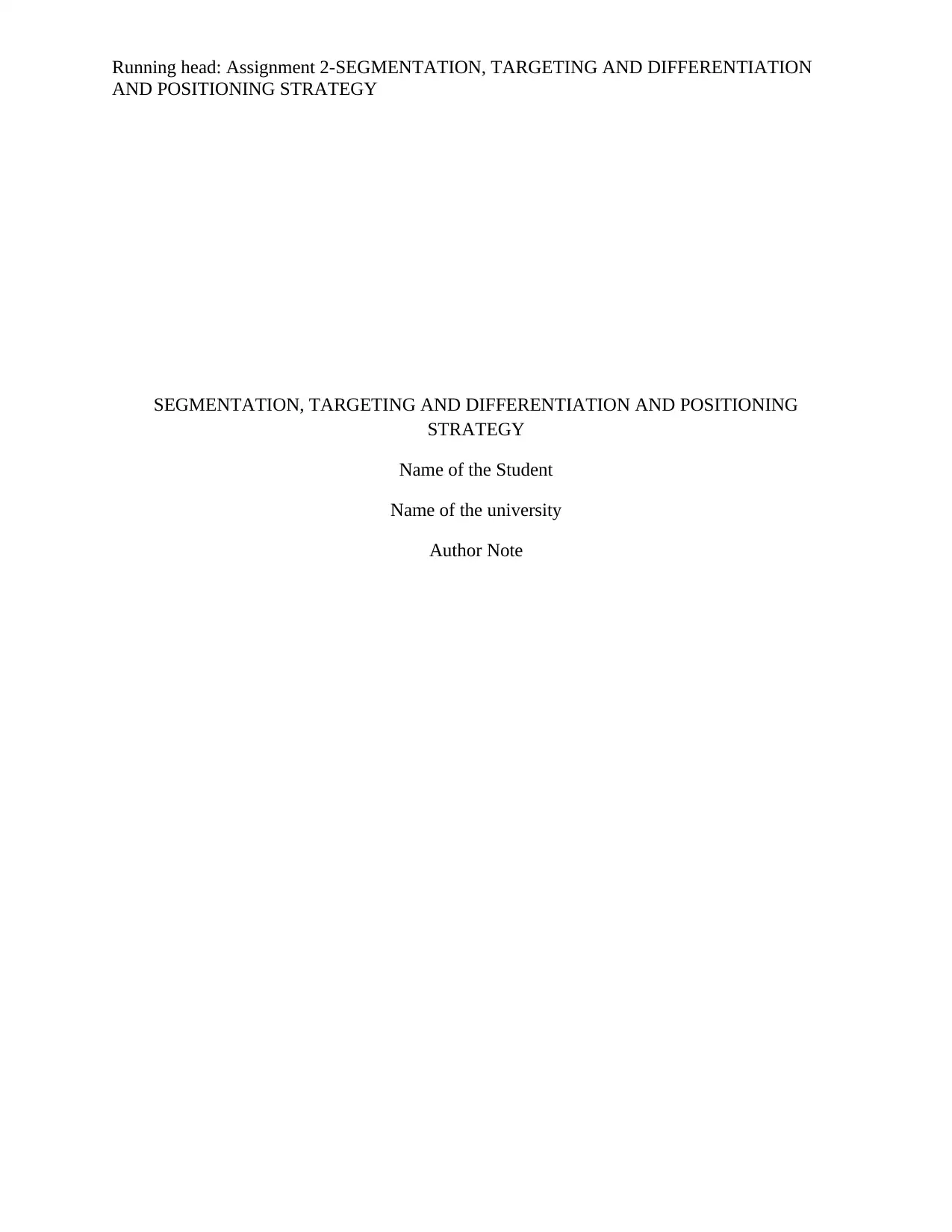
Running head: Assignment 2-SEGMENTATION, TARGETING AND DIFFERENTIATION
AND POSITIONING STRATEGY
SEGMENTATION, TARGETING AND DIFFERENTIATION AND POSITIONING
STRATEGY
Name of the Student
Name of the university
Author Note
AND POSITIONING STRATEGY
SEGMENTATION, TARGETING AND DIFFERENTIATION AND POSITIONING
STRATEGY
Name of the Student
Name of the university
Author Note
Secure Best Marks with AI Grader
Need help grading? Try our AI Grader for instant feedback on your assignments.
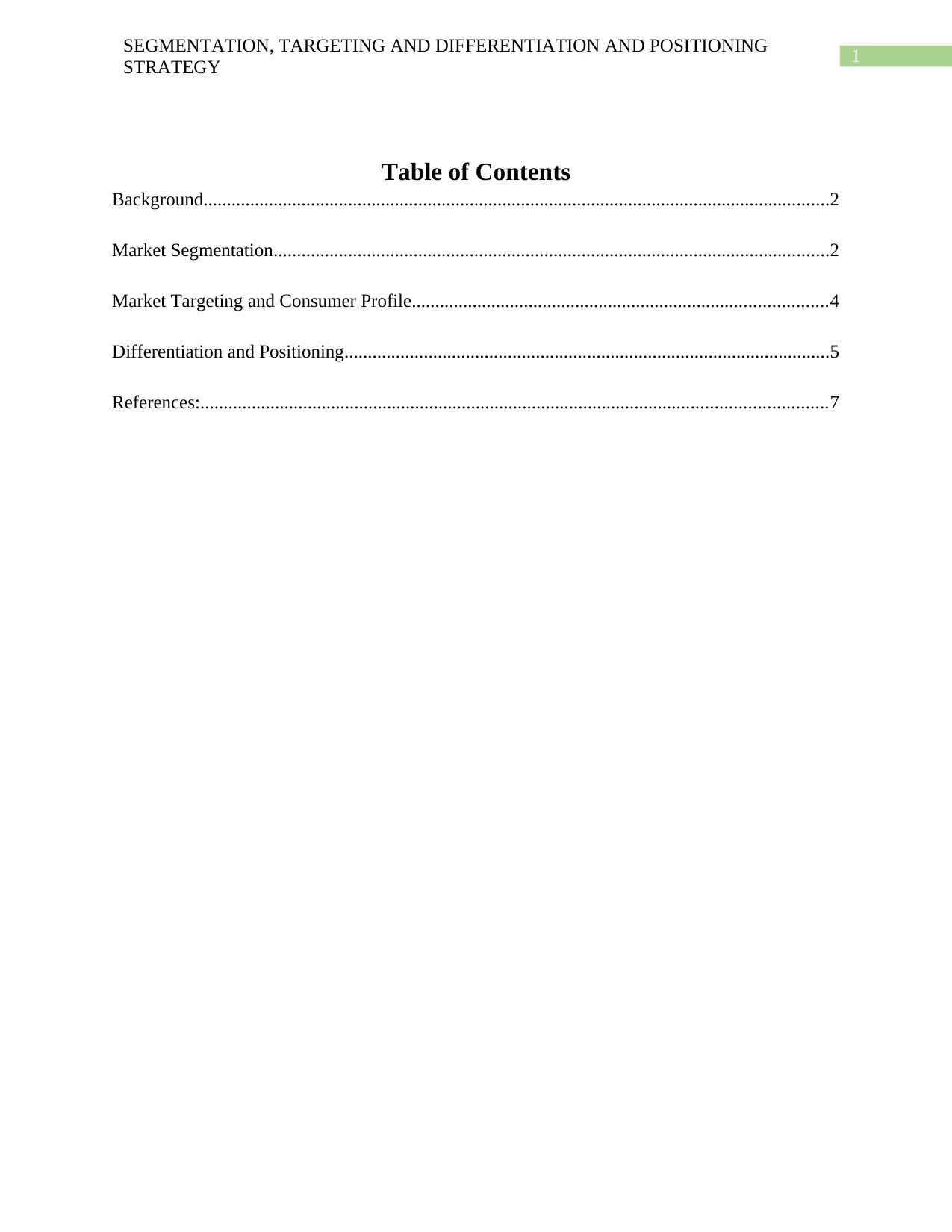
1
SEGMENTATION, TARGETING AND DIFFERENTIATION AND POSITIONING
STRATEGY
Table of Contents
Background......................................................................................................................................2
Market Segmentation.......................................................................................................................2
Market Targeting and Consumer Profile.........................................................................................4
Differentiation and Positioning........................................................................................................5
References:......................................................................................................................................7
SEGMENTATION, TARGETING AND DIFFERENTIATION AND POSITIONING
STRATEGY
Table of Contents
Background......................................................................................................................................2
Market Segmentation.......................................................................................................................2
Market Targeting and Consumer Profile.........................................................................................4
Differentiation and Positioning........................................................................................................5
References:......................................................................................................................................7
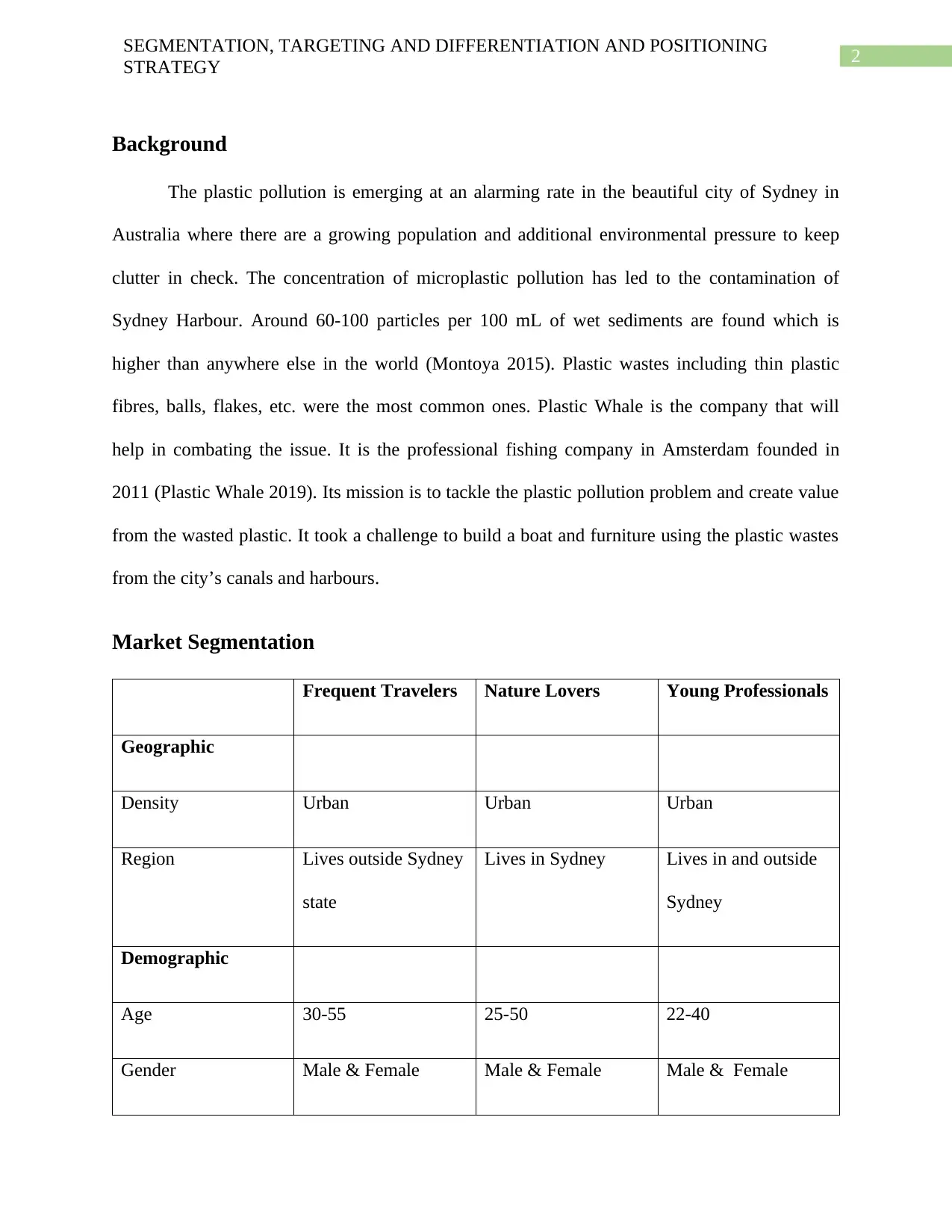
2
SEGMENTATION, TARGETING AND DIFFERENTIATION AND POSITIONING
STRATEGY
Background
The plastic pollution is emerging at an alarming rate in the beautiful city of Sydney in
Australia where there are a growing population and additional environmental pressure to keep
clutter in check. The concentration of microplastic pollution has led to the contamination of
Sydney Harbour. Around 60-100 particles per 100 mL of wet sediments are found which is
higher than anywhere else in the world (Montoya 2015). Plastic wastes including thin plastic
fibres, balls, flakes, etc. were the most common ones. Plastic Whale is the company that will
help in combating the issue. It is the professional fishing company in Amsterdam founded in
2011 (Plastic Whale 2019). Its mission is to tackle the plastic pollution problem and create value
from the wasted plastic. It took a challenge to build a boat and furniture using the plastic wastes
from the city’s canals and harbours.
Market Segmentation
Frequent Travelers Nature Lovers Young Professionals
Geographic
Density Urban Urban Urban
Region Lives outside Sydney
state
Lives in Sydney Lives in and outside
Sydney
Demographic
Age 30-55 25-50 22-40
Gender Male & Female Male & Female Male & Female
SEGMENTATION, TARGETING AND DIFFERENTIATION AND POSITIONING
STRATEGY
Background
The plastic pollution is emerging at an alarming rate in the beautiful city of Sydney in
Australia where there are a growing population and additional environmental pressure to keep
clutter in check. The concentration of microplastic pollution has led to the contamination of
Sydney Harbour. Around 60-100 particles per 100 mL of wet sediments are found which is
higher than anywhere else in the world (Montoya 2015). Plastic wastes including thin plastic
fibres, balls, flakes, etc. were the most common ones. Plastic Whale is the company that will
help in combating the issue. It is the professional fishing company in Amsterdam founded in
2011 (Plastic Whale 2019). Its mission is to tackle the plastic pollution problem and create value
from the wasted plastic. It took a challenge to build a boat and furniture using the plastic wastes
from the city’s canals and harbours.
Market Segmentation
Frequent Travelers Nature Lovers Young Professionals
Geographic
Density Urban Urban Urban
Region Lives outside Sydney
state
Lives in Sydney Lives in and outside
Sydney
Demographic
Age 30-55 25-50 22-40
Gender Male & Female Male & Female Male & Female
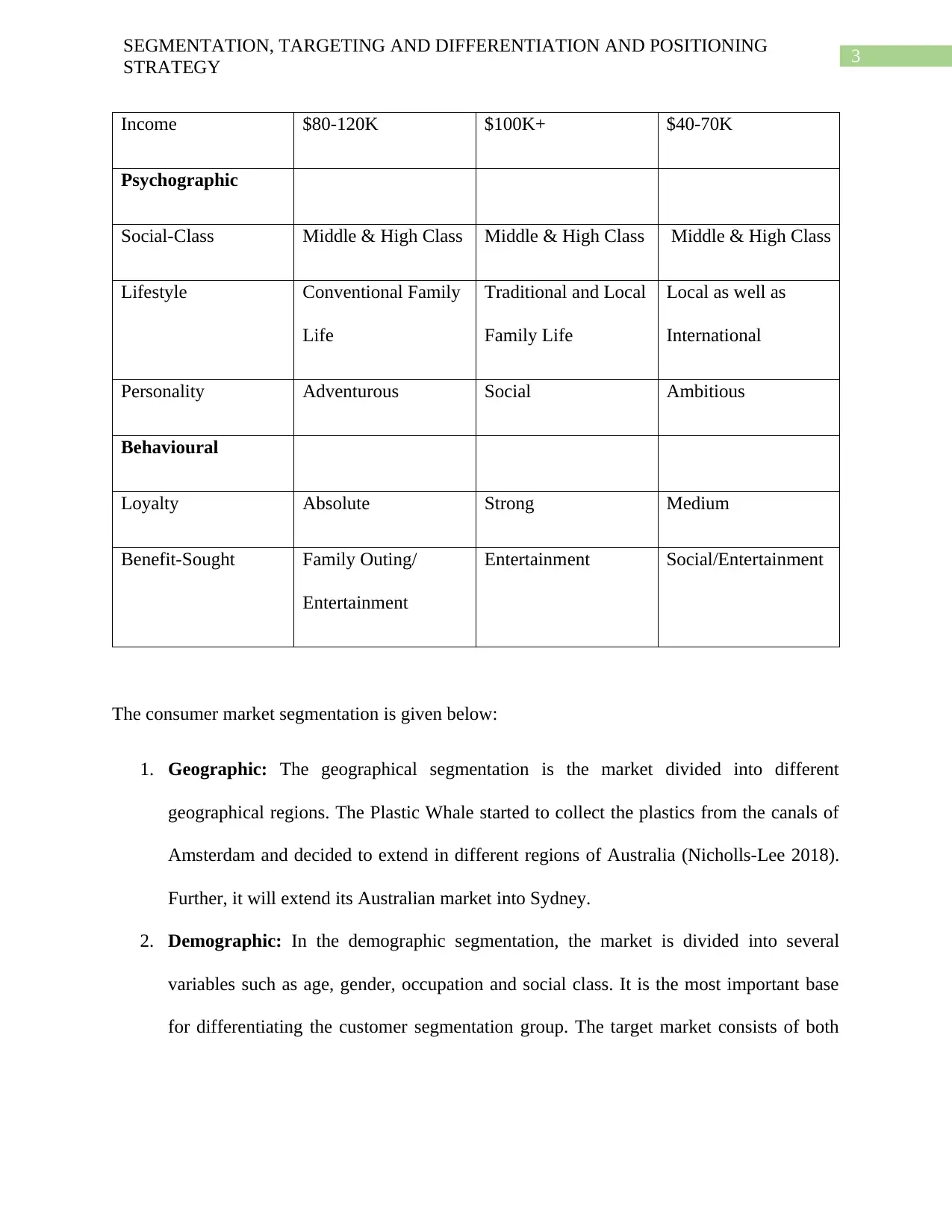
3
SEGMENTATION, TARGETING AND DIFFERENTIATION AND POSITIONING
STRATEGY
Income $80-120K $100K+ $40-70K
Psychographic
Social-Class Middle & High Class Middle & High Class Middle & High Class
Lifestyle Conventional Family
Life
Traditional and Local
Family Life
Local as well as
International
Personality Adventurous Social Ambitious
Behavioural
Loyalty Absolute Strong Medium
Benefit-Sought Family Outing/
Entertainment
Entertainment Social/Entertainment
The consumer market segmentation is given below:
1. Geographic: The geographical segmentation is the market divided into different
geographical regions. The Plastic Whale started to collect the plastics from the canals of
Amsterdam and decided to extend in different regions of Australia (Nicholls-Lee 2018).
Further, it will extend its Australian market into Sydney.
2. Demographic: In the demographic segmentation, the market is divided into several
variables such as age, gender, occupation and social class. It is the most important base
for differentiating the customer segmentation group. The target market consists of both
SEGMENTATION, TARGETING AND DIFFERENTIATION AND POSITIONING
STRATEGY
Income $80-120K $100K+ $40-70K
Psychographic
Social-Class Middle & High Class Middle & High Class Middle & High Class
Lifestyle Conventional Family
Life
Traditional and Local
Family Life
Local as well as
International
Personality Adventurous Social Ambitious
Behavioural
Loyalty Absolute Strong Medium
Benefit-Sought Family Outing/
Entertainment
Entertainment Social/Entertainment
The consumer market segmentation is given below:
1. Geographic: The geographical segmentation is the market divided into different
geographical regions. The Plastic Whale started to collect the plastics from the canals of
Amsterdam and decided to extend in different regions of Australia (Nicholls-Lee 2018).
Further, it will extend its Australian market into Sydney.
2. Demographic: In the demographic segmentation, the market is divided into several
variables such as age, gender, occupation and social class. It is the most important base
for differentiating the customer segmentation group. The target market consists of both
Secure Best Marks with AI Grader
Need help grading? Try our AI Grader for instant feedback on your assignments.
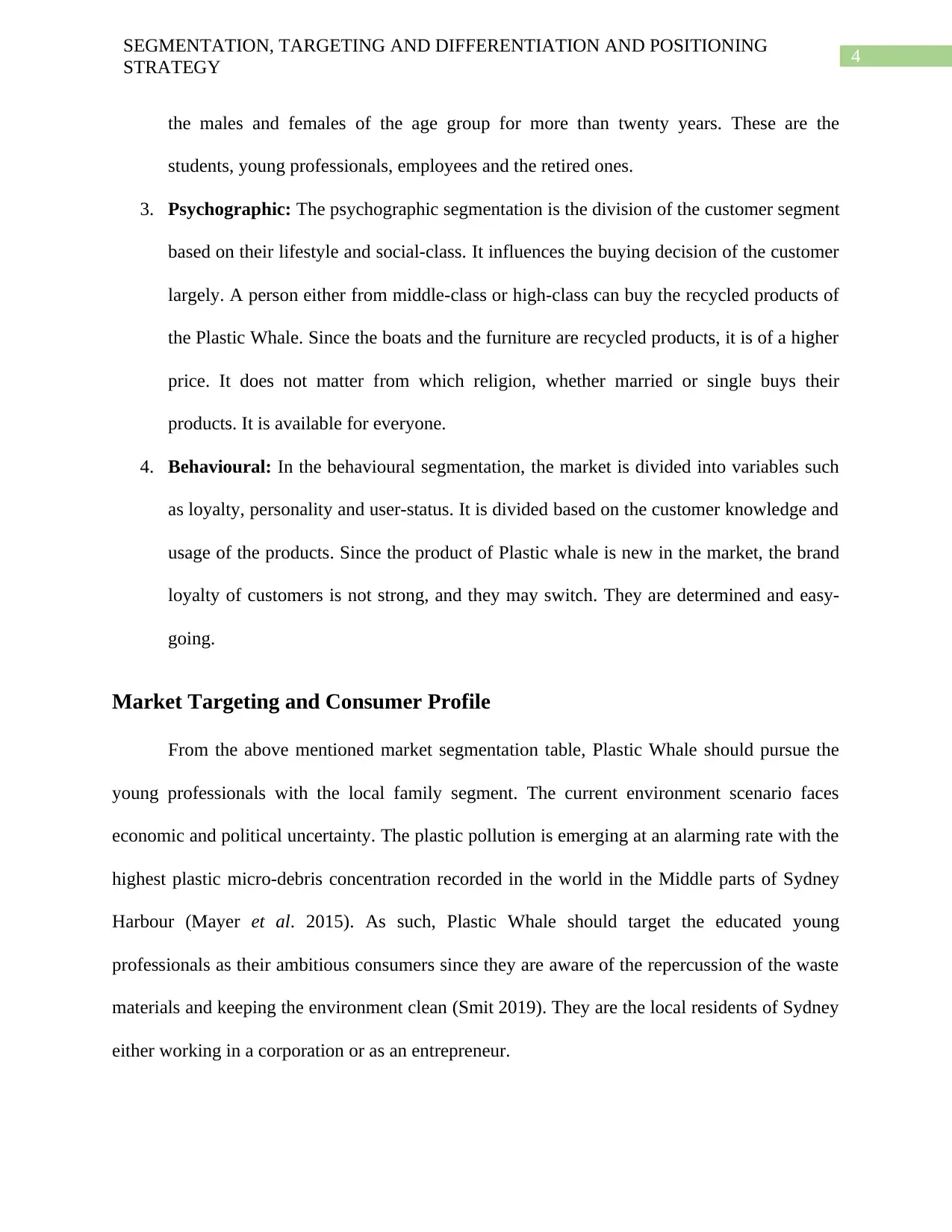
4
SEGMENTATION, TARGETING AND DIFFERENTIATION AND POSITIONING
STRATEGY
the males and females of the age group for more than twenty years. These are the
students, young professionals, employees and the retired ones.
3. Psychographic: The psychographic segmentation is the division of the customer segment
based on their lifestyle and social-class. It influences the buying decision of the customer
largely. A person either from middle-class or high-class can buy the recycled products of
the Plastic Whale. Since the boats and the furniture are recycled products, it is of a higher
price. It does not matter from which religion, whether married or single buys their
products. It is available for everyone.
4. Behavioural: In the behavioural segmentation, the market is divided into variables such
as loyalty, personality and user-status. It is divided based on the customer knowledge and
usage of the products. Since the product of Plastic whale is new in the market, the brand
loyalty of customers is not strong, and they may switch. They are determined and easy-
going.
Market Targeting and Consumer Profile
From the above mentioned market segmentation table, Plastic Whale should pursue the
young professionals with the local family segment. The current environment scenario faces
economic and political uncertainty. The plastic pollution is emerging at an alarming rate with the
highest plastic micro-debris concentration recorded in the world in the Middle parts of Sydney
Harbour (Mayer et al. 2015). As such, Plastic Whale should target the educated young
professionals as their ambitious consumers since they are aware of the repercussion of the waste
materials and keeping the environment clean (Smit 2019). They are the local residents of Sydney
either working in a corporation or as an entrepreneur.
SEGMENTATION, TARGETING AND DIFFERENTIATION AND POSITIONING
STRATEGY
the males and females of the age group for more than twenty years. These are the
students, young professionals, employees and the retired ones.
3. Psychographic: The psychographic segmentation is the division of the customer segment
based on their lifestyle and social-class. It influences the buying decision of the customer
largely. A person either from middle-class or high-class can buy the recycled products of
the Plastic Whale. Since the boats and the furniture are recycled products, it is of a higher
price. It does not matter from which religion, whether married or single buys their
products. It is available for everyone.
4. Behavioural: In the behavioural segmentation, the market is divided into variables such
as loyalty, personality and user-status. It is divided based on the customer knowledge and
usage of the products. Since the product of Plastic whale is new in the market, the brand
loyalty of customers is not strong, and they may switch. They are determined and easy-
going.
Market Targeting and Consumer Profile
From the above mentioned market segmentation table, Plastic Whale should pursue the
young professionals with the local family segment. The current environment scenario faces
economic and political uncertainty. The plastic pollution is emerging at an alarming rate with the
highest plastic micro-debris concentration recorded in the world in the Middle parts of Sydney
Harbour (Mayer et al. 2015). As such, Plastic Whale should target the educated young
professionals as their ambitious consumers since they are aware of the repercussion of the waste
materials and keeping the environment clean (Smit 2019). They are the local residents of Sydney
either working in a corporation or as an entrepreneur.
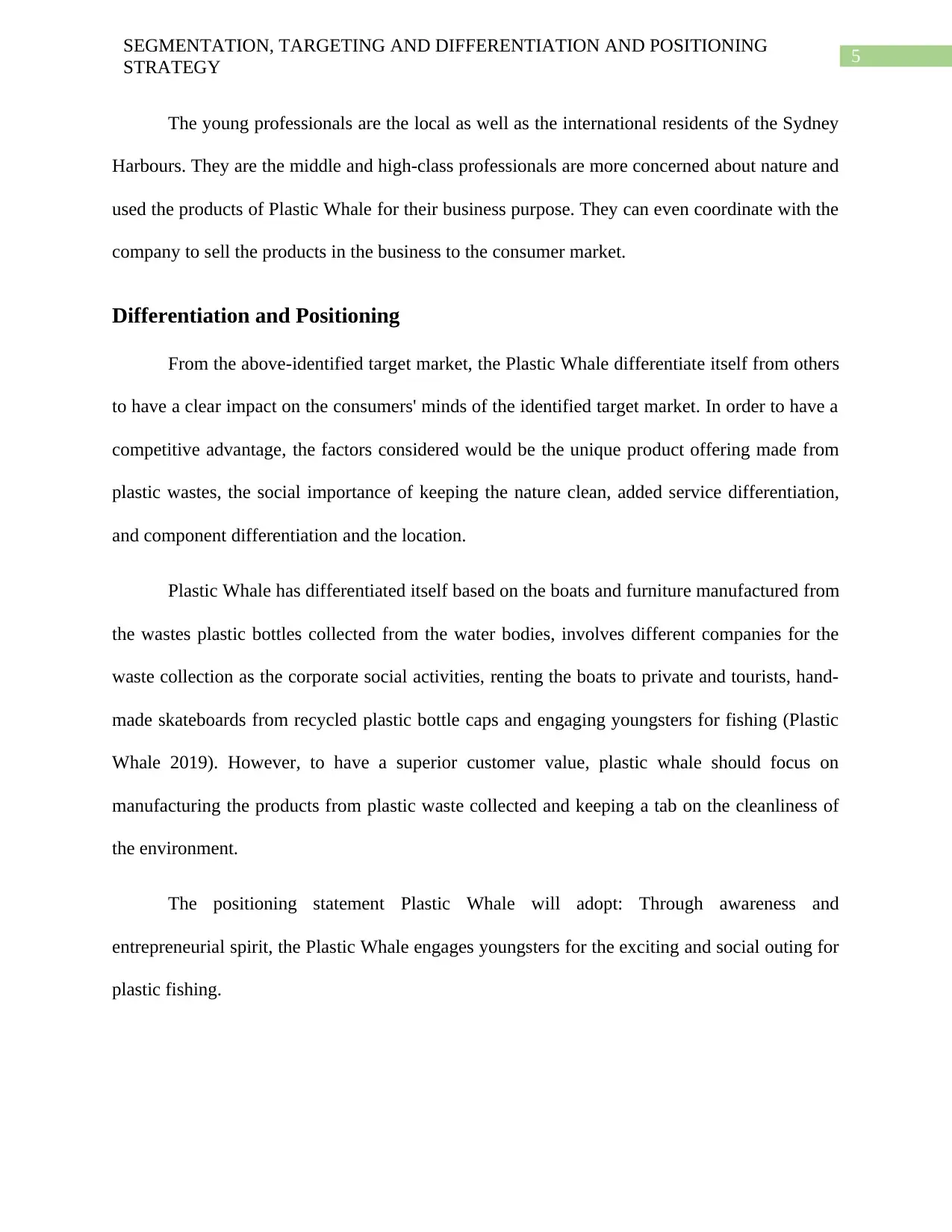
5
SEGMENTATION, TARGETING AND DIFFERENTIATION AND POSITIONING
STRATEGY
The young professionals are the local as well as the international residents of the Sydney
Harbours. They are the middle and high-class professionals are more concerned about nature and
used the products of Plastic Whale for their business purpose. They can even coordinate with the
company to sell the products in the business to the consumer market.
Differentiation and Positioning
From the above-identified target market, the Plastic Whale differentiate itself from others
to have a clear impact on the consumers' minds of the identified target market. In order to have a
competitive advantage, the factors considered would be the unique product offering made from
plastic wastes, the social importance of keeping the nature clean, added service differentiation,
and component differentiation and the location.
Plastic Whale has differentiated itself based on the boats and furniture manufactured from
the wastes plastic bottles collected from the water bodies, involves different companies for the
waste collection as the corporate social activities, renting the boats to private and tourists, hand-
made skateboards from recycled plastic bottle caps and engaging youngsters for fishing (Plastic
Whale 2019). However, to have a superior customer value, plastic whale should focus on
manufacturing the products from plastic waste collected and keeping a tab on the cleanliness of
the environment.
The positioning statement Plastic Whale will adopt: Through awareness and
entrepreneurial spirit, the Plastic Whale engages youngsters for the exciting and social outing for
plastic fishing.
SEGMENTATION, TARGETING AND DIFFERENTIATION AND POSITIONING
STRATEGY
The young professionals are the local as well as the international residents of the Sydney
Harbours. They are the middle and high-class professionals are more concerned about nature and
used the products of Plastic Whale for their business purpose. They can even coordinate with the
company to sell the products in the business to the consumer market.
Differentiation and Positioning
From the above-identified target market, the Plastic Whale differentiate itself from others
to have a clear impact on the consumers' minds of the identified target market. In order to have a
competitive advantage, the factors considered would be the unique product offering made from
plastic wastes, the social importance of keeping the nature clean, added service differentiation,
and component differentiation and the location.
Plastic Whale has differentiated itself based on the boats and furniture manufactured from
the wastes plastic bottles collected from the water bodies, involves different companies for the
waste collection as the corporate social activities, renting the boats to private and tourists, hand-
made skateboards from recycled plastic bottle caps and engaging youngsters for fishing (Plastic
Whale 2019). However, to have a superior customer value, plastic whale should focus on
manufacturing the products from plastic waste collected and keeping a tab on the cleanliness of
the environment.
The positioning statement Plastic Whale will adopt: Through awareness and
entrepreneurial spirit, the Plastic Whale engages youngsters for the exciting and social outing for
plastic fishing.
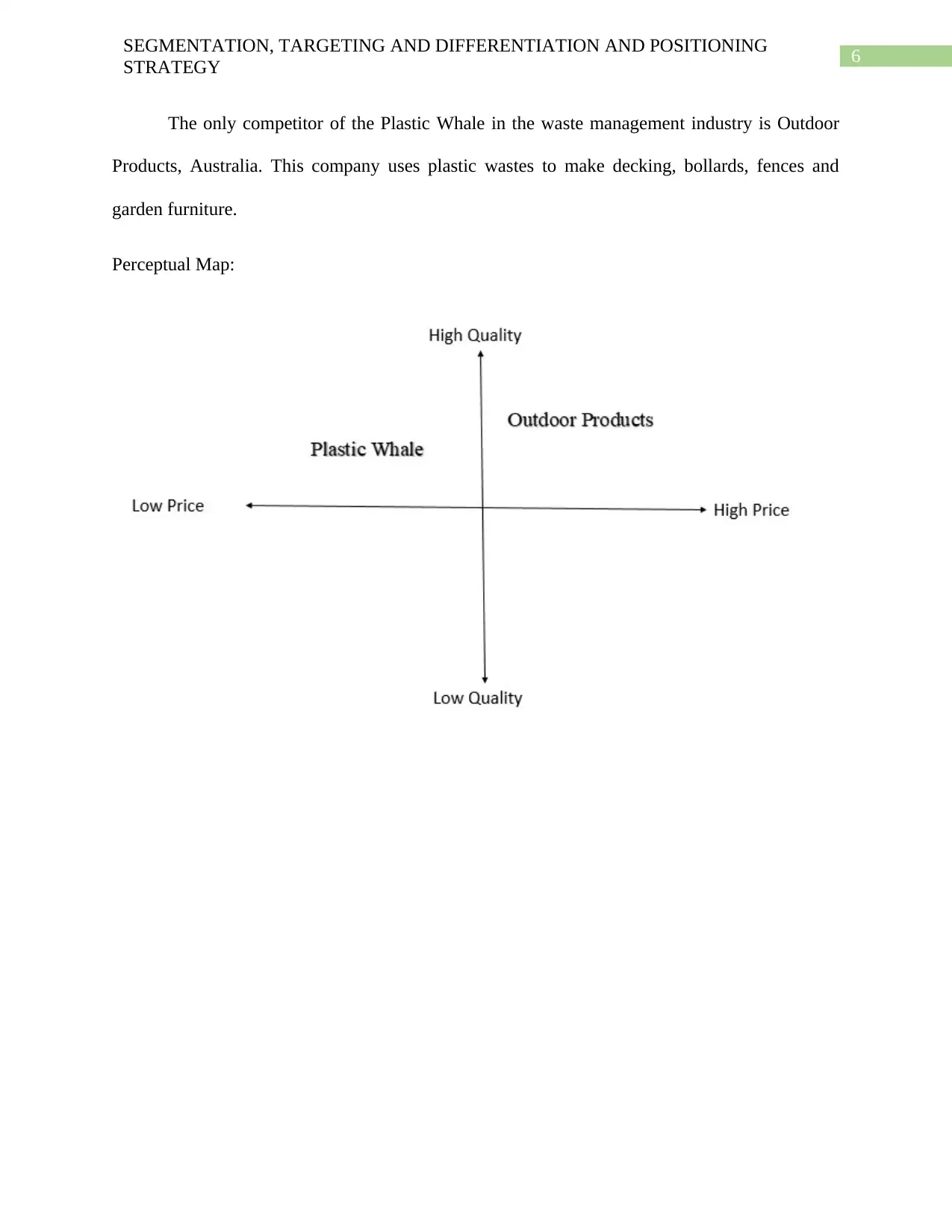
6
SEGMENTATION, TARGETING AND DIFFERENTIATION AND POSITIONING
STRATEGY
The only competitor of the Plastic Whale in the waste management industry is Outdoor
Products, Australia. This company uses plastic wastes to make decking, bollards, fences and
garden furniture.
Perceptual Map:
SEGMENTATION, TARGETING AND DIFFERENTIATION AND POSITIONING
STRATEGY
The only competitor of the Plastic Whale in the waste management industry is Outdoor
Products, Australia. This company uses plastic wastes to make decking, bollards, fences and
garden furniture.
Perceptual Map:
Paraphrase This Document
Need a fresh take? Get an instant paraphrase of this document with our AI Paraphraser
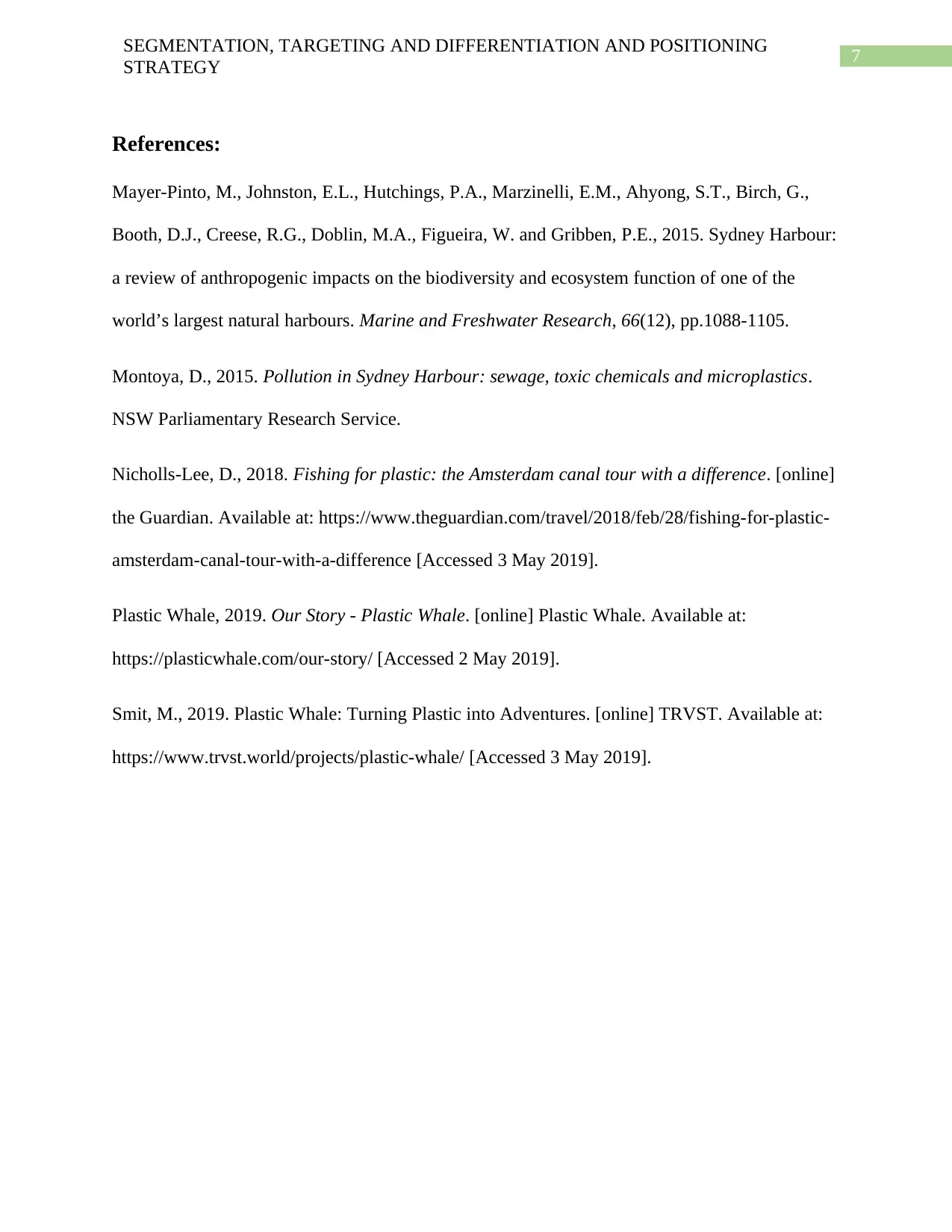
7
SEGMENTATION, TARGETING AND DIFFERENTIATION AND POSITIONING
STRATEGY
References:
Mayer-Pinto, M., Johnston, E.L., Hutchings, P.A., Marzinelli, E.M., Ahyong, S.T., Birch, G.,
Booth, D.J., Creese, R.G., Doblin, M.A., Figueira, W. and Gribben, P.E., 2015. Sydney Harbour:
a review of anthropogenic impacts on the biodiversity and ecosystem function of one of the
world’s largest natural harbours. Marine and Freshwater Research, 66(12), pp.1088-1105.
Montoya, D., 2015. Pollution in Sydney Harbour: sewage, toxic chemicals and microplastics.
NSW Parliamentary Research Service.
Nicholls-Lee, D., 2018. Fishing for plastic: the Amsterdam canal tour with a difference. [online]
the Guardian. Available at: https://www.theguardian.com/travel/2018/feb/28/fishing-for-plastic-
amsterdam-canal-tour-with-a-difference [Accessed 3 May 2019].
Plastic Whale, 2019. Our Story - Plastic Whale. [online] Plastic Whale. Available at:
https://plasticwhale.com/our-story/ [Accessed 2 May 2019].
Smit, M., 2019. Plastic Whale: Turning Plastic into Adventures. [online] TRVST. Available at:
https://www.trvst.world/projects/plastic-whale/ [Accessed 3 May 2019].
SEGMENTATION, TARGETING AND DIFFERENTIATION AND POSITIONING
STRATEGY
References:
Mayer-Pinto, M., Johnston, E.L., Hutchings, P.A., Marzinelli, E.M., Ahyong, S.T., Birch, G.,
Booth, D.J., Creese, R.G., Doblin, M.A., Figueira, W. and Gribben, P.E., 2015. Sydney Harbour:
a review of anthropogenic impacts on the biodiversity and ecosystem function of one of the
world’s largest natural harbours. Marine and Freshwater Research, 66(12), pp.1088-1105.
Montoya, D., 2015. Pollution in Sydney Harbour: sewage, toxic chemicals and microplastics.
NSW Parliamentary Research Service.
Nicholls-Lee, D., 2018. Fishing for plastic: the Amsterdam canal tour with a difference. [online]
the Guardian. Available at: https://www.theguardian.com/travel/2018/feb/28/fishing-for-plastic-
amsterdam-canal-tour-with-a-difference [Accessed 3 May 2019].
Plastic Whale, 2019. Our Story - Plastic Whale. [online] Plastic Whale. Available at:
https://plasticwhale.com/our-story/ [Accessed 2 May 2019].
Smit, M., 2019. Plastic Whale: Turning Plastic into Adventures. [online] TRVST. Available at:
https://www.trvst.world/projects/plastic-whale/ [Accessed 3 May 2019].
1 out of 8
Related Documents
Your All-in-One AI-Powered Toolkit for Academic Success.
+13062052269
info@desklib.com
Available 24*7 on WhatsApp / Email
![[object Object]](/_next/static/media/star-bottom.7253800d.svg)
Unlock your academic potential
© 2024 | Zucol Services PVT LTD | All rights reserved.




